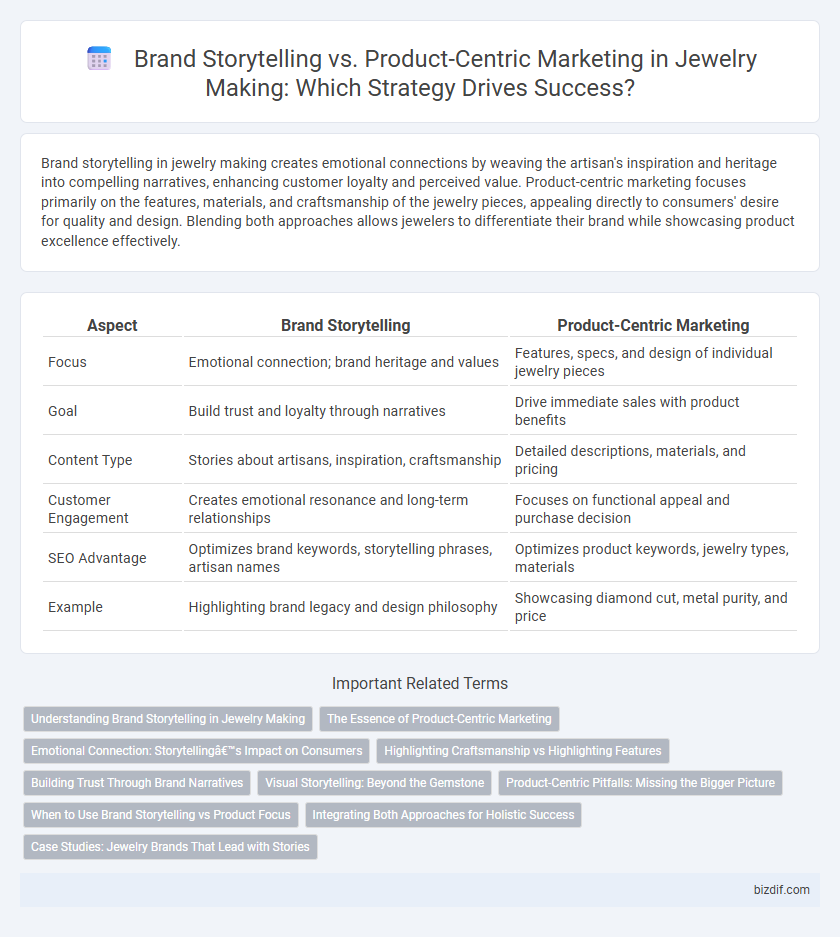Brand storytelling in jewelry making creates emotional connections by weaving the artisan's inspiration and heritage into compelling narratives, enhancing customer loyalty and perceived value. Product-centric marketing focuses primarily on the features, materials, and craftsmanship of the jewelry pieces, appealing directly to consumers' desire for quality and design. Blending both approaches allows jewelers to differentiate their brand while showcasing product excellence effectively.
Table of Comparison
| Aspect | Brand Storytelling | Product-Centric Marketing |
|---|---|---|
| Focus | Emotional connection; brand heritage and values | Features, specs, and design of individual jewelry pieces |
| Goal | Build trust and loyalty through narratives | Drive immediate sales with product benefits |
| Content Type | Stories about artisans, inspiration, craftsmanship | Detailed descriptions, materials, and pricing |
| Customer Engagement | Creates emotional resonance and long-term relationships | Focuses on functional appeal and purchase decision |
| SEO Advantage | Optimizes brand keywords, storytelling phrases, artisan names | Optimizes product keywords, jewelry types, materials |
| Example | Highlighting brand legacy and design philosophy | Showcasing diamond cut, metal purity, and price |
Understanding Brand Storytelling in Jewelry Making
Brand storytelling in jewelry making connects customers emotionally by sharing the inspiration, craftsmanship, and heritage behind each piece, differentiating the brand in a competitive market. Highlighting artisans' skills, cultural significance, and the journey from raw materials to finished jewelry enhances perceived value and customer loyalty. This approach shifts focus from mere product features to an immersive narrative that resonates deeply with consumers seeking meaningful and unique jewelry experiences.
The Essence of Product-Centric Marketing
Product-centric marketing in jewelry making emphasizes highlighting the craftsmanship, materials, and unique design elements of each piece to attract customers seeking quality and authenticity. It focuses on tangible product attributes like gemstone quality, metal purity, and intricate detailing, which set the jewelry apart in a competitive market. This approach appeals to buyers by showcasing the inherent value and artisanal excellence embedded in the jewelry itself.
Emotional Connection: Storytelling’s Impact on Consumers
Brand storytelling in jewelry making creates a powerful emotional connection by weaving personal narratives and heritage into each piece, enhancing perceived value and customer loyalty. Unlike product-centric marketing, which emphasizes features and specifications, storytelling taps into the consumer's identity and aspirations, driving deeper engagement and brand affinity. This emotional resonance leads to higher retention rates and increased word-of-mouth promotion within the competitive jewelry market.
Highlighting Craftsmanship vs Highlighting Features
Brand storytelling in jewelry making emphasizes the artisan's expertise, heritage, and the creative journey, creating an emotional connection that highlights the meticulous craftsmanship behind each piece. Product-centric marketing focuses on showcasing specific features such as gemstone quality, materials used, and design specifications to appeal to customer preferences and tangible attributes. Highlighting craftsmanship elevates brand value through authenticity, while emphasizing features drives purchase decisions by detailing product benefits and uniqueness.
Building Trust Through Brand Narratives
Brand storytelling in jewelry making builds trust by connecting emotionally with customers through authentic narratives that highlight craftsmanship, heritage, and values. This approach fosters deeper loyalty compared to product-centric marketing, which focuses narrowly on features and design details. By weaving meaningful stories, jewelers create a lasting brand identity that resonates and inspires confidence in buyers.
Visual Storytelling: Beyond the Gemstone
Visual storytelling in jewelry making transcends showcasing the gemstone by capturing the craftsmanship, heritage, and emotional connection embedded in each piece. Brands that leverage narratives about artisanship, cultural significance, and personal milestones create deeper engagement compared to product-centric marketing focused solely on features and specifications. This approach builds authentic brand identity and inspires loyalty by transforming jewelry into meaningful visual experiences beyond its material value.
Product-Centric Pitfalls: Missing the Bigger Picture
Focusing solely on product-centric marketing in jewelry making risks missing the emotional connection that brand storytelling builds with customers. This approach can limit engagement by emphasizing features and craftsmanship without conveying the brand's heritage, values, or unique narrative. Jewelry brands that neglect storytelling often struggle to differentiate themselves in a competitive market, reducing customer loyalty and long-term value.
When to Use Brand Storytelling vs Product Focus
Brand storytelling in jewelry making emphasizes the heritage, craftsmanship, and emotional connection behind the pieces, ideal for building long-term brand loyalty and differentiating in a crowded market. Product-centric marketing works best when promoting specific collections or highlighting unique design features and materials to drive immediate sales. Use brand storytelling during launch phases or rebranding efforts, while focusing on product details during targeted campaigns or seasonal promotions to maximize engagement and conversion.
Integrating Both Approaches for Holistic Success
Brand storytelling weaves emotional connections by highlighting the heritage, craftsmanship, and inspiration behind jewelry collections, creating lasting brand loyalty. Product-centric marketing emphasizes detailed descriptions, materials, and design innovations that showcase the value and quality of each piece. Integrating both approaches elevates customer engagement, blending narrative authenticity with tangible product benefits for a comprehensive marketing strategy in jewelry making.
Case Studies: Jewelry Brands That Lead with Stories
Jewelry brands like Tiffany & Co. and Pandora achieve higher customer engagement by emphasizing brand storytelling, weaving narratives around heritage, craftsmanship, and emotional connections. Case studies reveal that storytelling creates a deeper brand identity, fostering loyalty beyond product features or price points. Brands leading with stories consistently outperform product-centric competitors in both sales growth and brand equity.
Brand storytelling vs Product-centric marketing Infographic

 bizdif.com
bizdif.com